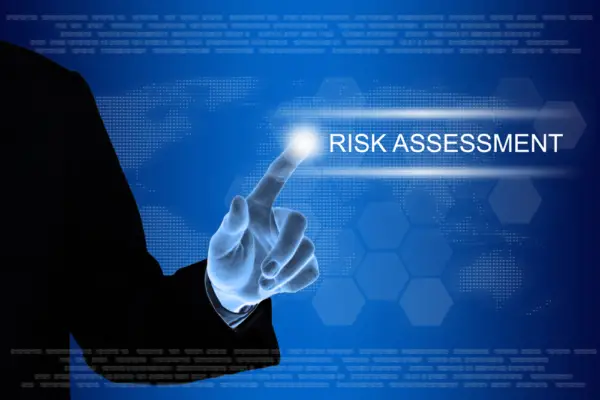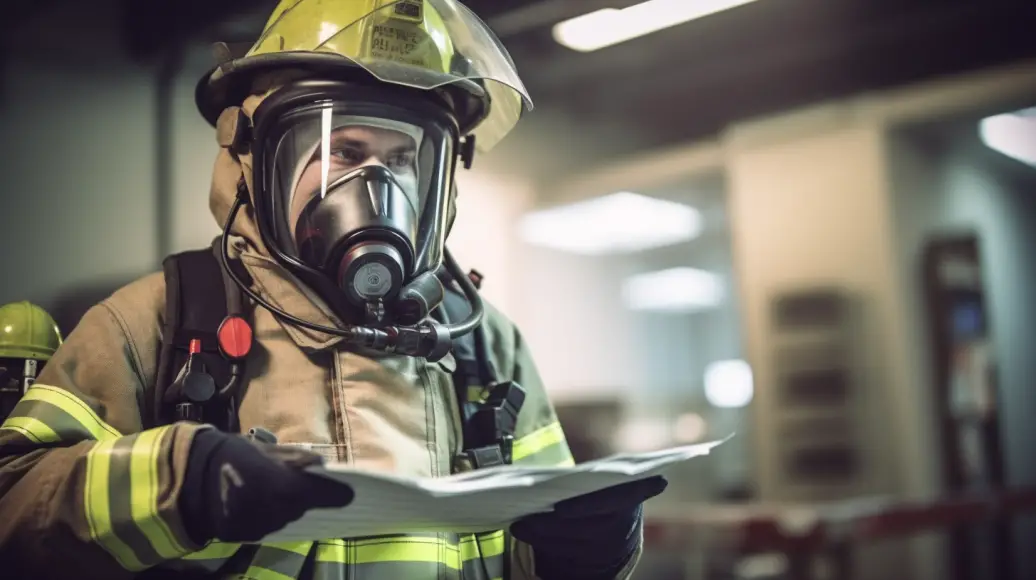Fire risk assessment constitutes a key component in safeguarding the safety and well-being of occupants within buildings and facilities.
It is a systematic evaluation process designed to identify potential fire hazards, assess existing safety measures, and determine the risk posed by fire.
The primary objective of this assessment is to reduce the likelihood of fire incidents, ensure effective preparedness in an emergency, and comply with relevant fire safety regulations.
This article explores the concept of fire risk assessment, its importance, the steps involved in its execution, and its associated roles and responsibilities.
The information provided aims to enhance understanding, promote adherence to safety standards, and foster a culture of vigilance and responsibility toward fire safety.

What is a Fire Risk Assessment?
A Fire Risk Assessment constitutes a systematic evaluation process, identifying potential fire hazards and risks within a particular environment, assessing their severity, and establishing appropriate safety measures to mitigate these threats.
It is a structured approach to understanding fire risk in a specific setting and people at risk.
The assessment process involves the identification of potential fire hazards, evaluating the risk they pose, and formulating an emergency plan and prevention measures to manage these risks.
As part of the risk assessments, a professional fire risk assessor determines the likelihood of a fire and its potential impact, outlining necessary safety measures to reduce the threat.
This assessment is critical in maintaining safety, minimizing damage, and protecting lives and property loss.
Why Conduct a Fire Risk Assessment?
Conducting a comprehensive evaluation of potential hazards is crucial to ensure the safety and well-being of individuals within a building and level of risk.
A fire risk assessment is a strategic process that aids in the identification and management of fire risks.
It is a legal requirement and an essential part of a comprehensive safety plan.
A fire risk assessment aims to reduce the likelihood of fire by identifying and controlling ignition sources and flammable materials. It allows for implementing effective fire safety measures, ensuring the protection of at-risk people.
It also contributes to developing an emergency evacuation plan, providing assurance in case of a fire.
Additionally, it ensures compliance with legal requirements, thereby avoiding penalties and demonstrating responsibility for the safety of occupants. It also assesses equipment like air conditioning systems.
How to Carryout Fire Risk Assessment
Conducting a fire risk assessment involves identifying potential fire hazards, varying in type and severity.
This is followed by critically evaluating these hazards to remove, reduce, and safeguard individuals from potential risks.
Subsequent steps involve documentation of all findings in a comprehensive report, development of a contingency plan, dissemination of information, provision of instructions and training, and a periodic review of the fire risk assessment to ensure its continued relevance and effectiveness.
First Step: Identify Fire Hazards
Initiating a comprehensive fire risk assessment necessitates first recognizing potential fire hazards within the premises. This process involves identifying all possible sources of ignition, including electrical equipment and heating appliances, and also locating combustible materials.
These might range from flammable ground cover to hazardous materials stored on-site. A thorough walkthrough inspection, guided by a comprehensive safety checklist, is crucial in detecting these hazards.
| Ignition Sources | Combustible Materials |
|---|---|
| Electrical equipment | Flammable ground cover |
| Heating appliances | Hazardous materials |
The table above emphasizes recognizing the ignition’s source and the combustible materials’ presence. Exit doors, people with disabilities exit in a block of flats is a legal requirement required when building blocks of flats.
Therefore, the first step in a fire risk assessment is identifying and evaluating these potential fire hazards. This is pivotal in laying the groundwork for preventive and protective measures.
Different Types of Fire Hazards
Understanding the diversity of potential hazards is crucial for effective prevention and protection measures. This involves distinguishing between threats, from electrical malfunctions to improperly stored flammable substances.
Regular fire risk assessments are essential in identifying these fire hazards and implementing identified fire safety measures.
Within the context of fire risk assessment, hazards can be categorized into three main types:
* Electrical Hazards – faulty wiring in electrical sockets, overloaded circuits, and improper use of electrical equipment can lead to fires. Precautionary fire measures should include regular inspection and maintenance of electrical installations.
* Flammable and Combustible Material Hazards – improper storage or disposal can ignite easily. Strict storage protocols and disposal procedures are vital precautionary measures. Example when handled by lone workers.
* Human Error – carelessness or negligence can cause fires. Fire safety measures should include regular fire safety training and awareness campaigns.

Third Step: Evaluate, Remove, Reduce, and Protect People from Risk
In this crucial third step, it is imperative to meticulously evaluate, eliminate, and reduce potential dangers while ensuring people are adequately protected in building safer environments.
This process is a key component of any comprehensive fire risk assessment and contributes significantly to the overall safety management of a facility.
The evaluation phase involves identifying all potential fire hazards and assessing their potential impact.
Following this, actions are taken to remove these potential dangers or reduce their threat level. However, it is not always possible to entirely eliminate all risks.
In such situations, protection measures are implemented to safeguard individuals from the remaining risks. Ultimately, the fundamental aim of this step is to protect people from risk, enhancing the environment’s safety.
Fourth Step: Record, Plan, Inform, Instruct, and Train
The fourth phase of this comprehensive safety procedure necessitates meticulous recording, planning, and providing instruction and training to all relevant personnel.
This ensures that a competent person designs an action plan to keep people safe in the event of a fire.
This phase requires a comprehensive assessment outlining the risk of ignition and the safety systems designed to mitigate such risks. The plan should be clearly communicated to all relevant persons, ensuring they are well-informed about the measures.
Training should be provided to enhance their understanding of the risks and their role in preventing a fire.
This phase concludes the fire risk assessment, ensuring a robust and efficient response to potential fire hazards.
To ensure the safety of individuals and properties against fires, it is important to know current fire safety measures. This includes understanding the use of portable fire extinguishers and egress fire doors and implementing passive fire protection and precautionary fire measures.
Managers of office properties should be aware of hazards and prescribed fire safety requirements and develop a floor plan to assess risks to people.
Additionally, Type 4 FRAs and code-based risk assessment tools can be used to evaluate the level of compliance and identify necessary protection systems.
It is important to consider the type of premises, such as complex structures, and ensure adequate measures for exits and space around structures.
The London Fire Brigade and National Fire Alarm and Signaling Code provide valuable resources and academic and regulatory systems. It is essential to prioritize safety in all properties and reduce the risk of extreme or moderate harm.
Fifth Step: Review Fire Risk Assessment
Regular revisions of the safety evaluation regarding potential combustion hazards are essential to ensure its efficacy and relevance.
As part of the fifth step: review fire risk assessment, the developed fire risk assessment tool is utilized to examine the compliance level with the established safety guidelines.
The process includes:
– Regular examination of the implemented safeguards using the developed checklist.
– Analysis of regular inspection records to identify any overlooked or newly emerged fire risks.
– Consultation with the facilities management team to gain insights into potential hazards and the effectiveness of current preventive measures.
This process helps ensure the fire risk assessment is up-to-date and provides a robust defense against potential fire hazards.
Who is responsible for carrying out a fire risk assessment?
Undeniably, the responsibility for carrying out a fire risk assessment typically rests on the shoulders of the property owner or employer. This is a task that demands utmost diligence and precision to ensure the safety of all occupants.
The responsible person is bound by safety law to perform comprehensive fire risk assessments according to the guidelines set by the National Fire Protection Association.
The assessment involves identifying potential fire hazards, analyzing building occupants’ vulnerability, and formulating prevention requirements.
Failure to adhere to these vital responsibilities can result in severe legal consequences. Furthermore, collaboration with local fire and rescue services is also recommended to ensure the effectiveness of the assessment.
The responsible person needs to conduct thorough fire risk assessments to prevent any fire-related incidents and ensure the safety of everyone inside the building. This plays a crucial role in maintaining a safe environment for all occupants.
Frequently Asked Questions
What qualifications are required to conduct a fire risk assessment?
Qualifications for risk assessment include risk identification, evaluation, and control knowledge.
Specifically for fire, understanding fire safety regulations, hazard assessment, and fire prevention measures are crucial. Professional certification may be necessary.
How often should a fire risk assessment be performed?
The frequency of conducting a risk assessment is contingent upon various factors. However, it is generally recommended that it be performed annually. In high-risk environments, more frequent evaluations may be necessary to ensure safety.
Are there different types of fire risk assessments for various kinds of businesses or properties?
Yes, varying types of fire risk assessments exist, tailored to different businesses and properties. Property type, size, usage, and occupant capacity can necessitate distinct approaches to ensure effective hazard identification and risk mitigation.
Can a business be penalized for not conducting a fire risk assessment?
Yes, businesses can face penalties for non-compliance with regulations requiring risk assessments. This can include fines or, in severe cases, imprisonment, highlighting the importance of adherence to safety guidelines and legal obligations.
What are some common mistakes made during a fire risk assessment?
Common mistakes during risk assessments include inadequate evaluation of potential hazards, failing to involve all stakeholders, neglecting to update the assessment regularly, and not providing sufficient training to the responsible individuals.

Conclusion
To sum up, the significance of conducting a Fire Risk Assessment cannot be emphasized enough. It is a crucial step in guaranteeing the well-being of people and assets.
It is a systematic process that identifies potential fire hazards and evaluates their associated risk. Responsibility for conducting a Fire Risk Assessment typically lies with the owner or occupier of a premise.
It is important to comprehend and apply this evaluation to prevent fire accidents, minimize potential harm, and write technical report that can be shared depending on jurisdictions, i.e., forest service.

Chris Ekai is a Risk Management expert with over 10 years of experience in the field. He has a Master’s(MSc) degree in Risk Management from University of Portsmouth and is a CPA and Finance professional. He currently works as a Content Manager at Risk Publishing, writing about Enterprise Risk Management, Business Continuity Management and Project Management.

